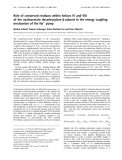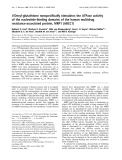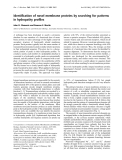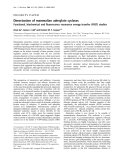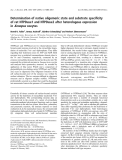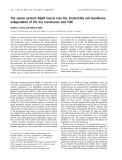
Transmembrane
-
Dystrobrevin is one of the intracellular components of the transmembrane dystrophin–glycoprotein complex (DGC). The functional role of this complex in normal and pathological situations has not yet been clearly established. Dystrobrevin disappears from the muscle membrane in Duchenne muscular dystrophy (DMD), which results from dystrophin mutations, as well as in limb girdle muscular dystrophies (LGMD), which results from mutations affecting other members of the DGC complex.
 6p
6p  system191
system191
 01-06-2013
01-06-2013
 34
34
 5
5
 Download
Download
-
Mikrobiologisches Institut der Eidgeno¨ssischen Technischen Hochschule, ETH-Zentrum, Zu¨rich, Switzerland The membrane-bound b subunit of the oxaloacetate decarboxylase Na+ pump of Klebsiella pneumoniae catalyzes the decarboxylation of enzyme-bound biotin. This event is coupled to the transport of 2 Na+ ions into the periplasm and consumes a periplasmically derived proton. The connecting fragment IIIa and transmembrane helices IV and VIII of the b subunit are highly conserved, harboring residues D203, Y229, N373, G377, S382, and R389 that play a profound role in catalysis. ...
 8p
8p  system191
system191
 01-06-2013
01-06-2013
 33
33
 4
4
 Download
Download
-
The siglecs (sialic acid-binding Ig-like lectins) are a distinct subset of the Ig superfamily with adhesion-molecule-like structure. We describe here a novel member of the siglec protein family that shares a similar structure including five Ig-like domains, a transmembrane domain, and a cytoplasmic tail containing two ITIM-signaling motifs. Siglec10 was identified through database mining of an asthmatic eosinophil EST library. Using the Stanford G3 radiation hybrid panel we were able to localize the genomic sequence of siglec-10 within the cluster of genes on chromosome 19q13.
 14p
14p  system191
system191
 01-06-2013
01-06-2013
 43
43
 6
6
 Download
Download
-
The human MUC4 gene encodes a large membrane-associated mucin, characterized by a mucin tandem repeat domain and a growth factor-like transmembrane domain. In addition to the originally published sequence (sv0-MUC4), several MUC4 cDNA sequences (called sv1-MUC4 to sv21MUC4, MUC4/X, MUC4/Y) from various tissues and cell lines have been recently described. They differ from sv0MUC4 by deletions and/or insertions located in the 3¢ region or, for two of them, by deletion of the central repetitive domain.
 8p
8p  research12
research12
 01-06-2013
01-06-2013
 42
42
 4
4
 Download
Download
-
The human multidrug resistance-associated protein (MRP1) is an ATP-dependent efflux pump that transports anionic conjugates, and hydrophobic compounds in a glutathione dependent manner. Similar to the other, well-characterized multidrug transporter P-gp, MRP1 comprises two nucleotide-binding domains (NBDs) in addition to transmembrane domains. However, whereas the NBDs of P-gp have been shown to be functionally equivalent, those of MRP1 differ significantly.
 9p
9p  research12
research12
 01-06-2013
01-06-2013
 25
25
 4
4
 Download
Download
-
A technique has been developed to search a proteome database for new members of a functional class of membrane protein. It takes advantage of the highly conserved secondary structure of functionally related membrane proteins. Such proteins typically have the same number of transmembrane domains located at similar relative positions in their polypeptide sequence. This gives rise to a characteristic pattern of peaks in their hydropathy profiles.
 7p
7p  research12
research12
 01-06-2013
01-06-2013
 32
32
 4
4
 Download
Download
-
Csk-binding protein⁄phosphoprotein associated with glycosphingolipid-enriched domains is a transmembrane adaptor protein primarily involved in negative regulation of T-cell activation by recruitment of C-terminal Src kinase (Csk), a protein tyrosine kinase which represses Src kinase activity through C-terminal phosphorylation. Recruitment of Csk occurs via SH2-domain binding to PAG pTyr317, thus, the interaction is highly dependent on phosphorylation performed by the Src family kinase Fyn, which docks onto PAG using a dual-domain binding mode involving both SH3- and SH2-domains of Fyn....
 12p
12p  research12
research12
 29-04-2013
29-04-2013
 40
40
 3
3
 Download
Download
-
Vibrio choleraehemolysin (HlyA), a water-soluble protein with a native monomeric relative molecular mass of 65 000, forms transmembrane pentameric channels in target bio-membranes.TheHlyAbinds to lipid vesicles nonspecifically and without saturation; however, self-assembly is triggered specifically by cholesterol.Here we show that the HlyA partitioned quantitatively to amphiphilic media irrespective of their compositions, indicating that the toxin had an amphiphilic surface.
 8p
8p  research12
research12
 23-04-2013
23-04-2013
 56
56
 4
4
 Download
Download
-
Mammalian adenylate cyclases are predicted to possess complex topologies, comprising two cassettes of six trans-membrane-spanningmotifs followedbyacytosolic, catalytic ATP-binding domain. Recent studies have begun to provide insights on the tertiary assembly of these proteins; crystal-lographic analysis has revealed that the two cytosolic domains dimerize to forma catalytic core, whilemore recent biochemical and cell biological analysis shows that the two transmembrane cassettes also associate to facilitate the functional assembly and trackingof the enzyme. ...
 9p
9p  research12
research12
 23-04-2013
23-04-2013
 37
37
 2
2
 Download
Download
-
The cystic ®brosis transmembrane conductance regulator (CFTR) gene shows a complex pattern of expression, with temporal and spatial regulation that is not accounted for by elements in the promoter. One approach to identifying the regulatory elements forCFTRis the mapping of DNase I hypersensitive sites (DHS) within the locus. We previously identi®ed at least 12 clusters of DHS across theCFTRgene andhere further evaluateDHS in introns 2, 3, 10, 16, 17a, 18, 20 and 21 to assess their functional importance in regulation ofCFTRgene expression. ...
 7p
7p  research12
research12
 23-04-2013
23-04-2013
 30
30
 2
2
 Download
Download
-
BACE2 (Memapsin 1) is a membrane-bound aspartic pro-tease that is highlyhomologouswithBACE1 (Memapsin 2). While BACE1 processes the amyloid precursor protein (APP) at a key step in generating theb-amyloid peptide and presumably causes Alzheimer’s disease (AD), BACE2 has not been demonstrated to be directly involved in APP pro-cessing, and its physiological functions remain to be deter-mined.In vivo, BACE2 is expressed as a precursor protein containing pre-, pro-, protease, transmembrane, and cyto-solic domains/peptides....
 10p
10p  tumor12
tumor12
 22-04-2013
22-04-2013
 25
25
 2
2
 Download
Download
-
Homology modeling in combination with transmembrane topology predictions are used to build the atomic model of Neurospora crassaplasmamembrane H + -ATPase, using as template the 2.6 A ˚ crystal structure of rabbit sarcoplasmic reticulum Ca 2+ -ATPase [Toyoshima, C., Nakasako, M., Nomura, H. & Ogawa, H. (2000)Nature405, 647–655].
 13p
13p  tumor12
tumor12
 22-04-2013
22-04-2013
 36
36
 4
4
 Download
Download
-
The calcium-sensing receptor (CaR) belongs to family C of the G-protein coupled receptor superfamily. The receptor is believed to exist as a homodimer due to covalent and non-covalent interactions between the two amino terminal domains (ATDs). It is well established that agonist binding to family C receptors takes place at the ATD and that this causes theATDdimer to twist.However, very little isknown about the translationof theATDdimer twist intoG-protein coupling to the 7 transmembrane moieties (7TMs) of these receptor dimers....
 12p
12p  tumor12
tumor12
 22-04-2013
22-04-2013
 40
40
 2
2
 Download
Download
-
The thyrotropin receptor (TSHR) undergoes a cleavage at the cell membrane, leading to a heterodimer, comprising an aextracellular and a b-transmembrane and intracellular subunits, held togetherbydisulfidebonds.Moreover, part of the a-subunit of the receptor is shed from thyroid and transfected L cells.To understand the role of cleavage and shedding, we constructed deletion mutants starting, respectively, at the most N-terminal (S314), and C-terminal (L378) cleavage sites previously mapped, corresponding to free b1orb2-subunits without further modification of receptor structure....
 12p
12p  tumor12
tumor12
 20-04-2013
20-04-2013
 37
37
 2
2
 Download
Download
-
G-protein-coupled receptor kinase 2 (GRK2) is known to specifically phosphorylate the agonist-bound forms of G-protein-coupled receptors (GPCRs). This strict specificity is due at least partly to activation of GRK2 by agonist-bound GPCRs, in which basic residues in intracellular regions adjacent to transmembrane segments are thought to be involved. Tubulin was found to be phosphorylated by GRK2, but it remains unknown if tubulin can also serve as both a substrate and an activator for GRK2.
 10p
10p  tumor12
tumor12
 20-04-2013
20-04-2013
 21
21
 4
4
 Download
Download
-
A conserved putative dimerization GxxxG motif located in the unique membrane-spanning segment of the ATP syn-thase subunit e was altered in yeast both by insertion of an alanine residue and by replacement of glycine by leucine residues. These alterations led to the loss of subunit gand the loss of dimeric and oligomeric forms of the yeast ATP syn-thase. Furthermore,as in null mutants devoid of either subunit e or subunit g,mitochondria displayed anomalous morphologies with onion-like structures. ...
 10p
10p  fptmusic
fptmusic
 16-04-2013
16-04-2013
 47
47
 2
2
 Download
Download
-
NTPDase1 and NTPDase2 are two related plasma mem-brane-located enzymes involved in the extracellular degra-dation of nucleoside 5¢-tri- and -diphosphates. They differ regarding their hydrolysis ratios for ATP and ADP. Both enzymes have a predicted transmembrane domain close to the N- and C-terminus, respectively, connected by an extensive extracellular domain that carries the active site.We expressed the rat-derived enzymes inXenopus laevisoocytes and analyzed their quarternary structure.
 8p
8p  fptmusic
fptmusic
 16-04-2013
16-04-2013
 32
32
 5
5
 Download
Download
-
KdpD is a sensor kinase protein in the inner membrane of Escherichia colicontaining four transmembrane regions. The periplasmic loops connecting the transmembrane regions are intriguingly short and proteasemapping allowed us to only follow the translocation of the second periplasmic loop. The results show that neither the Sec translocase nor theYidCprotein are required formembrane insertion of the second loop ofKdpD.
 11p
11p  fptmusic
fptmusic
 16-04-2013
16-04-2013
 32
32
 4
4
 Download
Download
-
Dynamic protein–protein interactions are involved in most physiological processes and, in particular, for the formation of multiprotein signaling complexes at transmembrane receptors, adapter proteins and effector mole-cules. Because the unregulated induction of signaling complexes has sub-stantial clinical relevance, the investigation of these complexes is an active area of research.
 10p
10p  fptmusic
fptmusic
 12-04-2013
12-04-2013
 40
40
 3
3
 Download
Download
-
The natriuretic peptide receptor-A (NPR-A) is composed of an extracellu-lar ligand-binding domain, a transmembrane-spanning domain, a kinase homology domain (KHD) and a guanylyl cyclase domain. Because the presence of ATP or adenylylimidodiphosphate reduces atrial natriuretic peptide (ANP) binding and is required for maximal guanylyl cyclase activ-ity, a direct interaction of ATP with the receptor KHD domain is plaus-ible.
 12p
12p  fptmusic
fptmusic
 12-04-2013
12-04-2013
 36
36
 2
2
 Download
Download
CHỦ ĐỀ BẠN MUỐN TÌM










